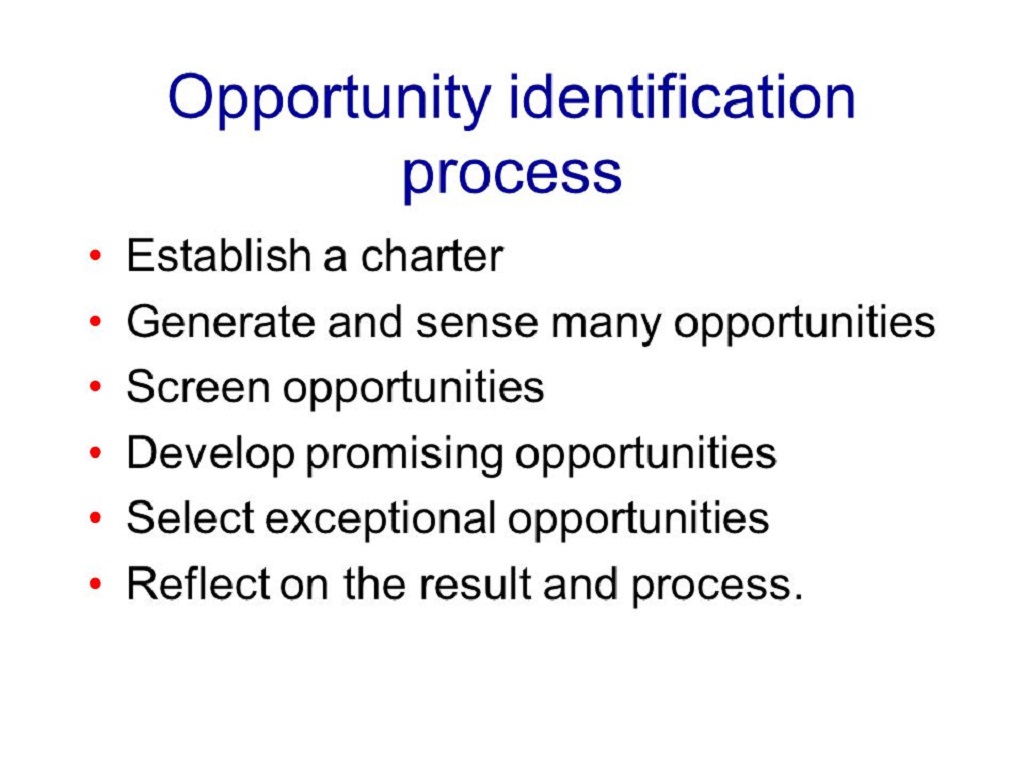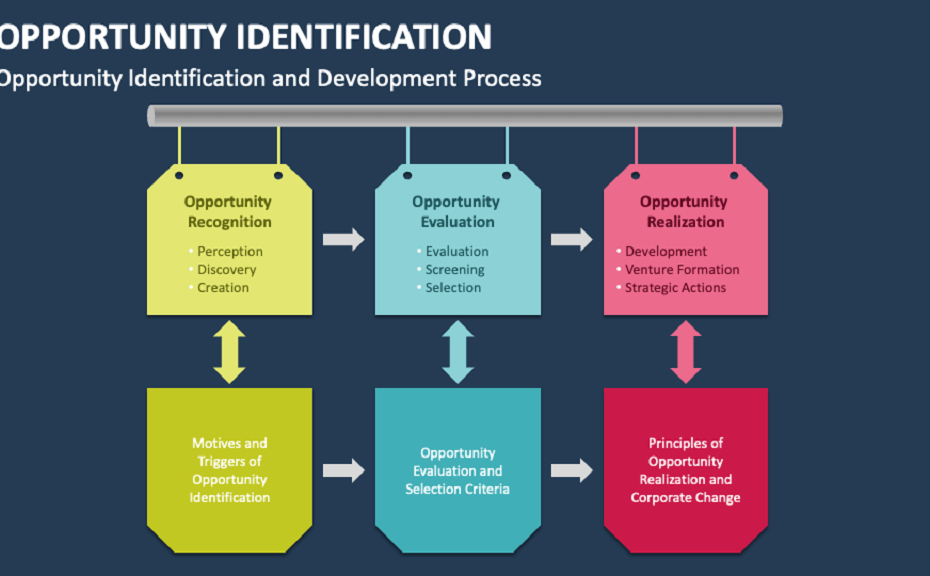The six steps in the opportunity identification process include testing execution, environmental assessment, purchasing analysis, competitor analysis, seeking similar opportunities, audience segmentation, and market profitability analysis. Effectively identifying and capitalizing on opportunities is crucial for business success.
Opportunity identification is a vital aspect of business strategy and growth. By following a systematic approach, organizations can uncover potential areas for growth, innovation, and competitive advantage. This process involves analyzing market trends, understanding customer needs, evaluating competition, and seeking untapped opportunities.
With the right tools and techniques, businesses can leverage their strengths and capitalize on emerging opportunities. Organizations can make informed decisions through a structured opportunity identification process and drive sustainable business growth.

Steps In the Opportunity Identification Process
Following a systematic approach to identify and leverage new business opportunities is crucial. The following six steps will guide you through the opportunity identification process:
Step 1: Execute Testing
Testing different strategies and ideas allows businesses to evaluate their potential and feasibility for success.
Step 2: Assess Environmental Factors
Assessing the environmental factors helps in understanding the external conditions that may impact the success of the market growth strategies the better bean opportunity.
Step 3: Perform Purchasing Analysis
Conducting a purchasing analysis assists in understanding potential consumers’ buying behavior and patterns.
Step 4: Know Your Competitors
Understanding your competitors’ strategies and offerings can provide insights into market positioning and opportunities for differentiation.
Step 5: Seek Similar Opportunities
Exploring related and similar opportunities can unveil new potential areas for business growth and development.
Step 6: Segment Your Audience And Perform Market Profitability
Segmenting your audience and analyzing market profitability helps identify target customer groups and their potential profitability.
Tools For Opportunity Identification
The six steps in the opportunity identification process include executing testing, assessing environmental factors, conducting purchasing analysis, understanding competitors, seeking similar opportunities, segmenting the audience, and analyzing market profitability to leverage your business. These methods, such as brainstorming, Crawford slip method, SWOT analysis, process flowcharting, reversing assumptions, and forcing associations, can help identify problems and opportunities.
What are the Six Steps in the Opportunity Identification Process?
Brainstorming Crawford Slip Method SWOT Analysis Process Flowcharting Reversing Assumptions Forcing Associations Opportunity identification is crucial to business strategy. By leveraging the right tools and techniques, organizations can uncover valuable opportunities for growth and innovation. Let’s explore six powerful methods for opportunity identification that can help businesses stay ahead in the competitive market:
Brainstorming
Brainstorming is a creative technique to generate many ideas within a specific time frame. It encourages participants to think outside the box and propose innovative solutions to identified problems or opportunities.
Crawford Slip Method
The Crawford Slip Method allows individuals to anonymously submit ideas or solutions to a specific problem or opportunity. This helps get diverse perspectives and prevents groupthink, enabling exploring a broader range of possibilities.
Swot Analysis
SWOT Analysis involves assessing a situation’s strengths, weaknesses, opportunities, and threats. This structured approach provides a comprehensive understanding of the internal and external factors that can impact an organization’s performance.
Process Flowcharting
Process Flowcharting visualizes the steps and decision-making processes involved in a business operation. This method helps identify inefficiencies, bottlenecks, or areas for improvement within the existing processes.
Reversing Assumptions
Reversing Assumptions involves challenging preconceived notions or assumptions about a problem or opportunity. By flipping the perspective, businesses can uncover alternative viewpoints and potential solutions that were initially overlooked.
Forcing Associations
Forcing Associations is a technique that involves linking unrelated concepts or ideas to identify potential connections and opportunities. This method encourages creative thinking and can lead to unconventional yet practical solutions. By leveraging these tools for opportunity identification, businesses can gain a competitive advantage by uncovering new prospects and enhancing their strategic decision-making process.
Four Pathways To Opportunity Identification
Identifying opportunities involves executing testing, assessing environmental factors, analyzing purchasing, understanding competitors, seeking similar opportunities, segmenting audiences, and evaluating market profitability to leverage your business. Tools like brainstorming, SWOT analysis, and process flowcharting can help in this process, while recognition stages include idea generation, opportunity identification, and development.
Opportunity identification is a crucial step in business growth, allowing organizations to uncover potential opportunities for innovation and growth. Businesses can follow four main pathways to identify these opportunities: organic result, opportunity recognition, opportunity development, and opportunity evaluation.
Organic Result
The organic result pathway refers to identifying opportunities through natural and unplanned means. This can occur through market research, customer feedback, or simply by being attentive to changes in the business environment. By closely examining industry trends and consumer needs, businesses can stumble upon valuable opportunities that can fuel their growth and success.
Opportunity Recognition
Opportunity recognition is another pathway to identifying new business opportunities. This pathway involves actively seeking opportunities by examining market gaps, customer pain points, and emerging trends. By proactively identifying these opportunities, organizations can stay ahead of the competition and position themselves as industry leaders.
Opportunity Development
Once an opportunity is recognized, developing it into a viable business concept is next. This pathway involves refining and shaping the initial idea into a concrete plan. This includes conducting market analysis, creating a value proposition, and designing a business model that aligns with the identified opportunity. Businesses can transform their ideas into profitable ventures by focusing on opportunity development.
Opportunity Evaluation
The final pathway is opportunity evaluation. This step involves assessing the feasibility and potential of an opportunity before committing resources to it. By conducting a thorough analysis of market demand, competition, financial projections, and risk factors, businesses can make informed decisions about whether to pursue the identified opportunity.
This evaluation process ensures that businesses focus on opportunities with the highest chances of success. The four pathways to opportunity identification – organic result, opportunity recognition, opportunity development, and opportunity evaluation – provide businesses with a structured approach to uncovering and capitalizing on new growth opportunities. By following these pathways, organizations can stay agile, innovative, and poised for long-term success in today’s dynamic business landscape.
Stages Of Opportunity Identification Process
The six steps in the opportunity identification process involve executing testing, assessing environmental factors, conducting purchasing analysis, understanding competitors, seeking similar opportunities, segmenting the audience, and evaluating market profitability to drive business growth. Various methods and tools, such as brainstorming, SWOT analysis, and process flowcharting, aid in problem and opportunity identification.
The stages of opportunity recognition include idea generation, opportunity identification, development, and evaluation.
The process of opportunity identification involves several stages. By following these stages, businesses can recognize and capitalize on potential opportunities. The six steps in the opportunity identification process are:
1. Getting An Idea
The first stage is getting an idea. This could be inspired by a problem that needs solving, a gap in the market, or a new technology that could be leveraged. Ideas can come from various sources, such as customer feedback, employees, market research, or personal experiences.
2. Opportunity Identification
Once an idea has been formed, the next stage is opportunity identification. This involves thoroughly researching the market, competitors, and target audience to determine the idea’s potential viability as a business opportunity. Assessing market trends, demand, and customer preferences is essential to validate the possible opportunity.
3. Opportunity Development
After identifying a promising opportunity, the next step is opportunity development. This stage involves brainstorming and refining the initial idea into a tangible concept. Businesses must determine how the opportunity will be addressed, including product or service development, market positioning, and resource allocation. It is crucial to consider feasibility, scalability, and competitive advantage factors during this stage.
4. Opportunity Evaluation
Once an opportunity has been developed, it needs to be evaluated rigorously. This stage involves assessing the financial viability, market potential, and risks associated with the chance. Businesses need to conduct thorough market research, competitive analysis, and financial projections to determine the profitability and sustainability of the opportunity. This evaluation helps in making informed decisions about pursuing or abandoning the opportunity.
Summary
Businesses can effectively recognize and evaluate potential business opportunities by following the six steps in the opportunity identification process. From getting an initial idea to thoroughly researching and evaluating the opportunity, each stage plays a vital role in maximizing the chances of success. It is essential to approach each stage with careful analysis, market knowledge, and strategic thinking to make informed decisions about pursuing opportunities.
The Opportunity Identification Process

Identifying and seizing opportunities is crucial for business success. The opportunity identification process allows firms to identify potential growth, innovation, and improvement areas. Businesses can effectively identify and take advantage of opportunities by following a systematic approach. This blog post will explore the six steps involved in the opportunity identification process.
Framing
The first step in the opportunity identification process is framing. This involves defining the identification process’s goals, objectives, and scope. Clearly outlining what the business hopes to achieve makes identifying opportunities that align with these objectives easier. Framing also helps companies to stay focused and prioritize their efforts.
Strategic Planning
Once the goals and objectives are defined, businesses move on to strategic planning. This step involves assessing the current market, analyzing industry trends, and understanding the competitive landscape. Businesses gain insights into potential opportunities that can be capitalized on by conducting a thorough analysis.
Identifying Urban Market Opportunities
One specific area of opportunity identification is identifying urban market opportunities. Urban markets often present unique opportunities due to their population density and diverse customer base. Businesses need to conduct market research, understand the needs and preferences of urban consumers, and identify gaps in the market that can be filled.
Overall, the opportunity identification process is vital to business growth and success. By following these six steps – framing, strategic planning, and identifying urban market opportunities – businesses can effectively identify and capitalize on opportunities for innovation, growth, and improvement.
Frequently Asked Questions On What Are The Six Steps In the Opportunity Identification Process?
What Are The Steps In Opportunity Identification?
The steps in opportunity identification include executing testing, assessing environmental factors, conducting purchasing analysis, understanding competitors, seeking similar opportunities, segmenting the audience, and evaluating market profitability. These steps help leverage your business.
What Are The 7 Elements Of Opportunity Assessment?
The seven elements of opportunity assessment include testing, environmental analysis, purchasing analysis, competitor research, exploring similar opportunities, audience segmentation, and market profitability analysis. These steps help leverage your business.
What Are The Tools For Opportunity Identification?
Opportunities can be identified using brainstorming, the Crawford slip method, SWOT analysis, process flowcharting, reversing assumptions, and forcing associations. These methods can help identify problems and opportunities for business growth.
What Are The Four Pathways To Opportunity Identification?
The four pathways to opportunity identification include executing testing, assessing environmental factors, conducting purchasing analysis, and knowing your competitors. These steps help leverage your business and identify potential opportunities.
Conclusion
The six steps in the opportunity identification process are crucial for businesses to succeed. Businesses can fully leverage their potential by executing testing, assessing environmental factors, conducting purchasing analysis, understanding competitors, seeking similar opportunities, segmenting the audience, and performing market profitability analysis.
Embracing the realm of online business not only expands your financial horizons but also enhances your overall life by providing a platform where these steps help recognize needs, define problems, develop initial solutions, and think divergently and convergently to create innovative and unique value propositions, fostering personal growth and professional fulfillment. By following this process, businesses can identify and capitalize on opportunities for successful growth and innovation.
